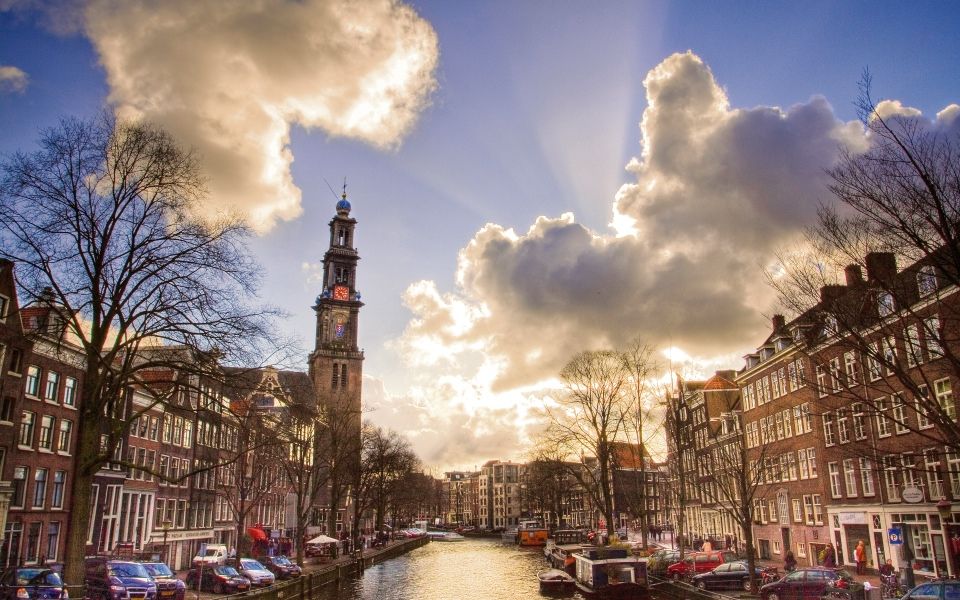What to do in Amsterdam when it’s very, very wet outside

Two things you should always pack for a quick city break: good shoes and a waterproof. Most cities are best viewed on foot. What interesting little side streets can a double decker bus tour ever take you down?
There’s nothing better than being able to duck unplanned into a cheese shop, or a bar (or another bar) for a bite and a drink or two. There are a couple of exceptions to this rule, of course. The old trams in Lisbon, for example, give you a view of the city that adds another layer of history and fun. They also save you from some thigh burning climbs.
The view from my room on the upper floors of the Mövenpick Hotel Amsterdam (thankfully accessible by lift) doesn’t include any hills. Amsterdam is, after all, pretty flat. There are trams, a river and, sprawling from it, the canals and boats and bicycles. There are also dark clouds approaching from the north and a wind with whip and bite. There’s little chance of sitting in a square watching the world go by in this weather.
Thankfully I have my coat and some walking boots. The weather soon puts pay to any idea of cycling; instead I take an early city boat tour to get my bearings.
It is a more comfortable way to appreciate the waterways than the alternatives. Swimming in a waterproof is no fun, even in sunshine, and ice-skates are of no use unless it is much, much colder. Sadly the deep frozen winters that used to provide opportunity for city-to-city speed skating are becoming few and very far between.
The view from a tour boat, with its glass walls and ceiling, could arguably be improved with some external wipers but this is certainly an interesting way to see the city. The floating greenhouses provide a perfect way to view Amsterdam’s architecture, its narrow houses and variety of gabled rooftops.
There are times I want to jump off and explore further, so be prepared for the full trip when you set sail, and a word of advice, try to avoid doing boat trips on a hangover.

Somewhere in Amsterdam that does welcome the rain occasionally – and provides enough protection so that you can enjoy yourself too – is De Hortus Botanicus.
The non-floating greenhouses here have been firmly rooted in the ground since 1638. This is one of the oldest botanic gardens in the world and the collection of over 4,000 plants provides a tranquil escape from the city. There are interesting self guided trails to follow, as well as free tours on Sunday.
I love the Three Climate Greenhouse. It is a genuine eye-catcher, designed in 1993 by Zwarts & Jansma Architects as a huge, ultramodern construction. It has zones representing the subtropics, the desert, and the tropics, each with its own temperature, humidity, and air circulation.
There is a fun treetop walk through, a tropical area dense with palms and a dry sandy zone full of Instagrammable cacti of all shapes and sizes.
On brighter days the outdoor gardens will look equally good but our tour hot foots to the Palm Greenhouse which accommodates a large collection of palms, cycads, and pot plants.
While most of the container plants are moved outside in summer, some, like the famous 350-year-old Eastern Cape giant cycad remain in the Palm Greenhouse all year round.
Walking past the culinary herbs and a greenhouse full of butterflies you’ll return to the Orangery building. The cafe in the building is one of my favourite spots in all of Amsterdam.
It’s a beautiful light space and the kitchen turns out well-considered organic meals. Combine your entrance ticket with a set lunch for the full experience.
Elsewhere, The Rijksmuseum is worth at least a day on its own (I try and squeeze the best bits into the afternoon). The museum building itself is impressive enough, cyclists and pedestrians are visible from the main hall, passing along the road that bisects the gallery’s interior.
The work on display is breathtaking, too. Get an audio-tour or book a guide to appreciate the subtleties of the masters of the Dutch Golden Age. Rembrandt’s The Night Watch, hung in the room of the same name, is a highlight of highlights. Vermeer, Verspronck and Van Ruisdael are veritable masters of light.
There’s only darkness outside when I am ushered from the building by the museum staff so I pull my hood up and yomp back to the hotel where free chocolate, drinks and a spa awaits.
After dinner, back in my room, the rain falls and the wind whips still, but I’m warm, well fed and enjoying the view. I rest my feet, open up the laptop and start to plan the things I’ll be doing when I come back to Amsterdam without (fingers crossed) the need for a waterproof. It might be a very different day.
Double rooms at the Mövenpick Hotel start from £98 per night based on two sharing, incl. free shuttle transfers from Centraal Station. For reservations visit movenpick.com or call 0800 898 317.
For further information on Amsterdam visit holland.com